The Sonoran Desert is a unique place that stretches across southwestern North America, covering large parts of Arizona, California, and Mexico. The desert is known for its extreme climate conditions, rugged landscapes, and rich biodiversity.
A significant part of this biodiversity includes birds that have adapted to survive in this arid environment. The Sonoran Desert is home to over 350 species of birds, including several rare and endangered ones.
In this article, we will discuss a list of birds found in the Sonoran Desert, highlighting the unique features and characteristics that make each one special.
From the iconic cactus wren to the elusive elf owl, the list includes some of the most captivating bird species found in this region.
1. Northern Cardinal
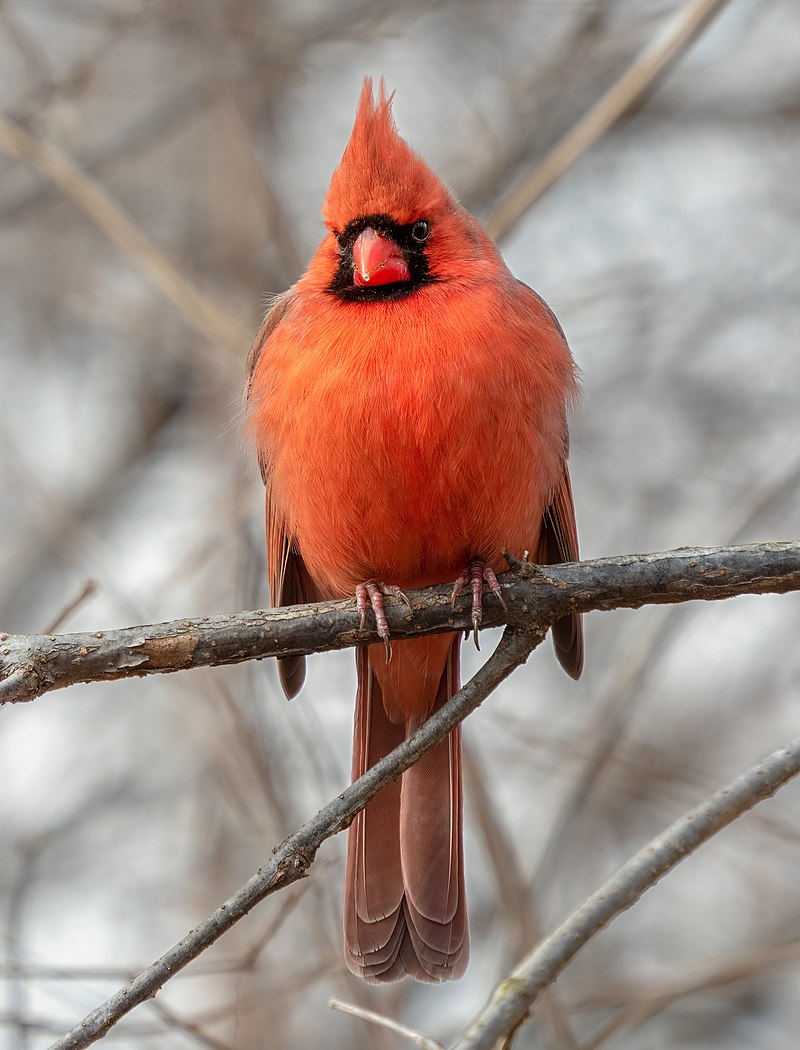
The Northern Cardinal is a beautiful bird, easily identified by its bright red plumage. It can be found in the eastern United States from Maine to Minnesota and south through Mexico and Belize.
Along with its striking colouration, it has a distinctive crest on its head and sharp black facial markings around the eyes.
Despite their small size (measuring 7-9 inches) they are very vocal birds – males sing persistently throughout springtime to attract mates or proclaim their territory.
They typically feed on insects, seeds and fruits but also enjoy suet at backyard bird feeders.
The female is less brightly coloured than her mate but still stands out among other songbirds due to her warm brownish-red feathers.
Cardinals pair for life so you may often see them together in your garden or neighbourhood park.Scientific classification:
| Kingdom | Animalia |
| Phylum | Chordata |
| Class | Aves |
| Order | Passeriformes |
| Family | Cardinalidae |
| Genus | Cardinalis |
| Species | C. cardinalis |
Also Featured In: Most Common United States Birds, Birds for Your Home Garden
2. Cactus Wren
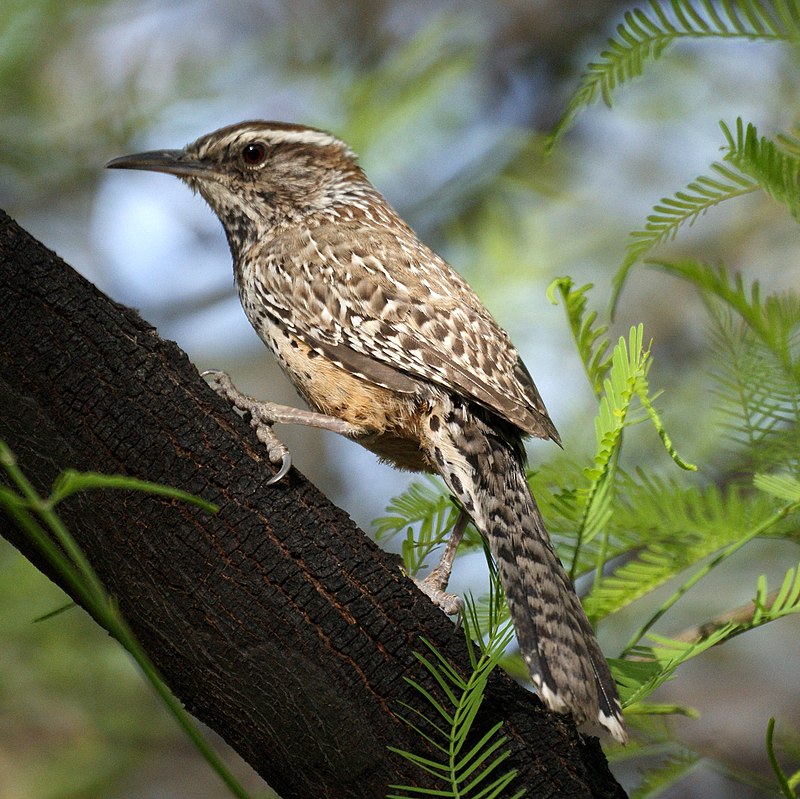
The cactus wren is an enchanting bird found in the deserts of the southwestern United States and northern and central Mexico.
It has a unique brown plumage, with black and white spots as markings, along with a distinctive white eyebrow sweeping to its nape.
Its chest is also snow-white, whereas its belly features light brown bars that contrast nicely against other feathers.
This species holds special significance for Arizona – it was declared their state bird due to its large size compared to other US wrens.
Cactus Wrens are often seen perched atop Saguaro cacti or jumping around on desert ground searching for food such as insects like beetles or spiders.Scientific classification:
| Kingdom | Animalia |
| Phylum | Chordata |
| Class | Aves |
| Order | Passeriformes |
| Family | Troglodytidae |
| Genus | Campylorhynchus |
| Species | C. brunneicapillus |
Also Featured In: Birds that Live in Chaparral, Brown Birds that Found in Texas
3. Greater Roadrunner
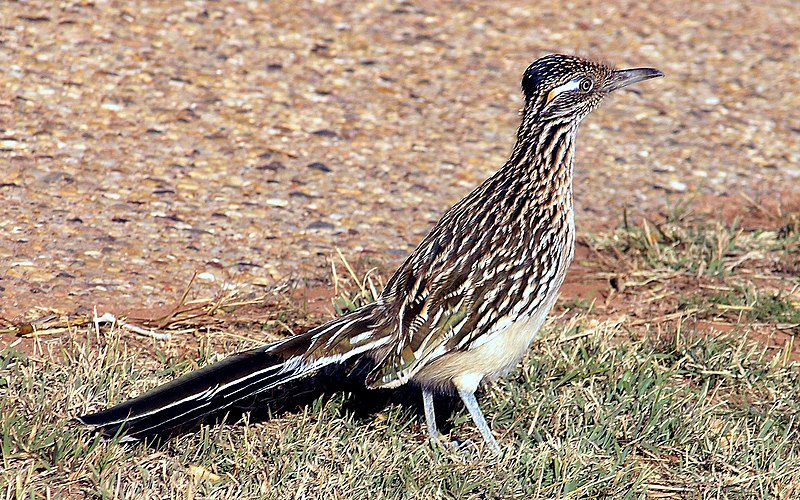
The Greater Roadrunner is a long-legged bird in the Cuculidae family that can be found throughout Aridoamerica. It has many nicknames, including Californian Earth-cuckoo, Chaparral Cock and Snake Killer.
This species is one of two birds belonging to the genus Geococcyx – the other being its smaller counterpart, Lesser Roadrunner.
The Greater Roadrunners are known to eat anything they can catch such as lizards, snakes and insects, making them very valuable predators for keeping pests at bay.
They also have an impressive burst of speed over short distances which helps with hunting prey or escaping danger quickly.
With their large eyes and distinctive black tip on their tail feathers, these amazing creatures make quite an impression when spotted out in nature.Scientific classification:
| Kingdom | Animalia |
| Phylum | Chordata |
| Class | Aves |
| Order | Cuculiformes |
| Family | Cuculidae |
| Genus | Geococcyx |
| Species | G. californianus |
4. House Finch

The House Finch is a species of finch native to western North America and has been introduced in the eastern half of the continent as well as Hawaii.
It’s an average-sized finch with adults measuring 12.5 – 15 cm (5 – 6 inches) long and having wingspans between 20 – 25 cm (8 – 10 inches).
The upperparts are brown, while its underparts range from pale grayish white to yellow depending on subspecies.
Its face is streaked or spotted with reddish coloration; males typically have brighter plumage than females due to sexual dimorphism.
They’re mostly found near human habitations such as farms and gardens where they feed on grains, fruits, insects etc., making them very popular among birders who want something colorful for their backyard.Scientific classification:
| Kingdom | Animalia |
| Phylum | Chordata |
| Class | Aves |
| Order | Passeriformes |
| Family | Fringillidae |
| Subfamily | Carduelinae |
| Genus | Haemorhous |
| Species | H. mexicanus |
Also Featured In: Most Common Winter Birds, Birds That Live in Colorado
5. Anna’s Hummingbird
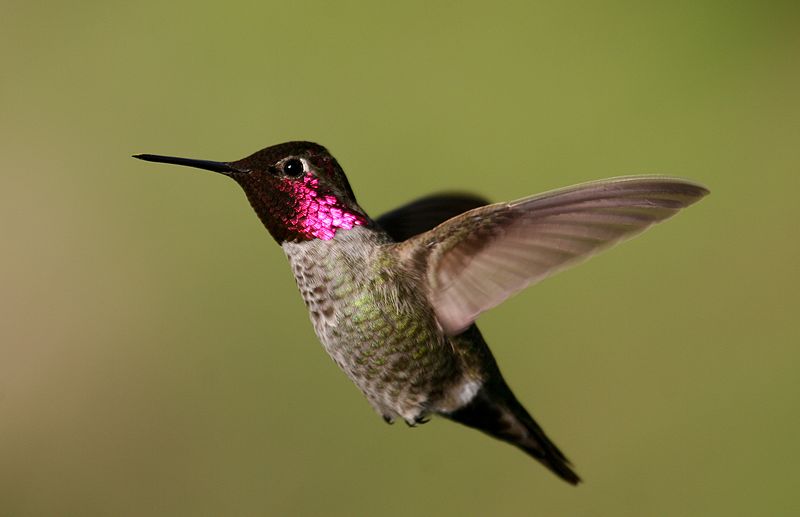
Anna’s hummingbird is a beautiful species of bird belonging to the Trochilidae family. Native to western coastal regions of North America, it was named after Anna Masséna, Duchess of Rivoli.
In the early 20th century, these birds bred only in northern Baja California and southern California but due to ornamental plant transplanting they can now be found across much of Pacific Coast region.
They are medium-sized with bright emerald green feathers on their back and crowns as well as rose-red patches at the throat for males which makes them quite distinguishable from other birds.
Their diet consists mainly nectar from flowers although they will occasionally feed on insects or spiders too making them important pollinators that help maintain healthy ecosystems.Scientific classification:
| Kingdom | Animalia |
| Phylum | Chordata |
| Class | Aves |
| Order | Apodiformes |
| Family | Trochilidae |
| Genus | Calypte |
| Species | C. anna |
Also Featured In: Flight Birds You Should Know, Birds Commonly Found in Northern California
6. Black-Chinned Hummingbird
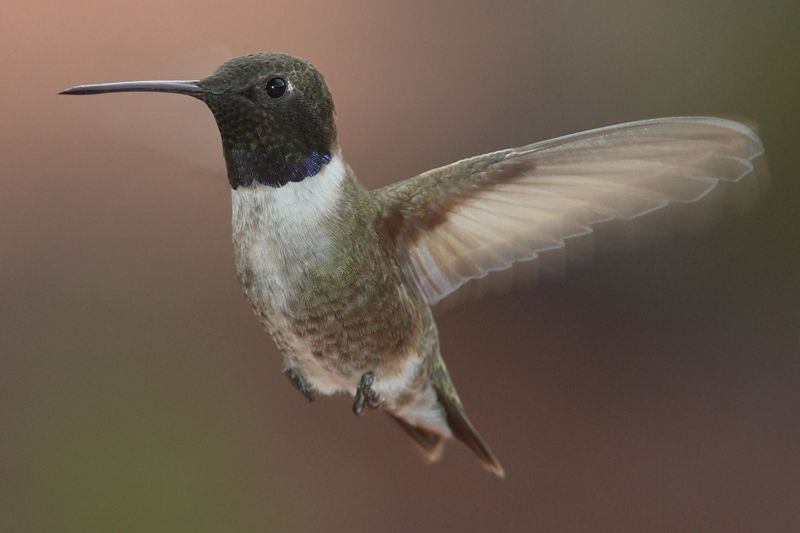
The Black-chinned Hummingbird (Archilochus alexandri) is a small but widely distributed bird. It migrates to Mexico for the winter months, and in summer can be found across much of North America.
The Black-chinned Hummingbird has been known to hybridize with several other species such as Anna’s, Lucifer, Broad-tailed and Costa’s hummingbirds.
It prefers open habitats like desert scrub or grasslands that provide plenty of nectar from flowers.
These birds are also capable flyers, able to reach speeds of up to 34 miles per hour. With its dazzling plumage and impressive flying skills the Black-chinned Hummingbird makes an intriguing sight for any nature enthusiast lucky enough spot one in the wild.Scientific classification:
| Kingdom | Animalia |
| Phylum | Chordata |
| Class | Aves |
| Order | Apodiformes |
| Family | Trochilidae |
| Genus | Archilochus |
| Species | A. alexandri |
Also Featured In: Most Popular Bird Species in North America, Central Texas Birds
7. Burrowing Owl
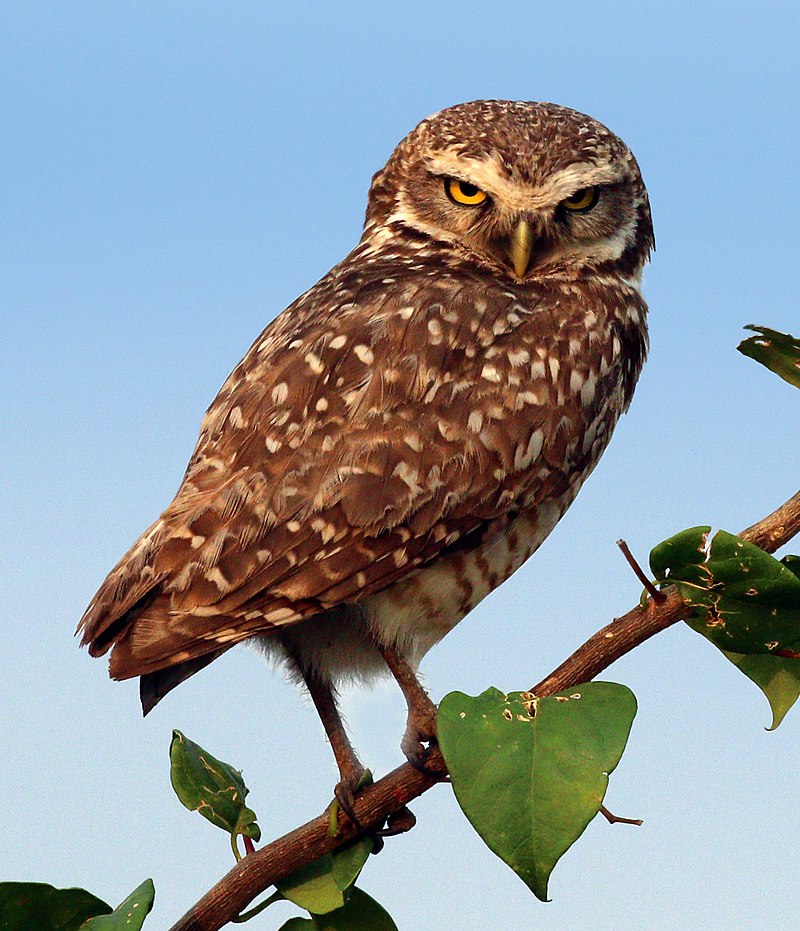
The Burrowing Owl is a small, long-legged owl found in open landscapes throughout North and South America. They are typically seen in grasslands, rangelands, agricultural areas or deserts with low vegetation.
Unlike most owls they nest and roost underground by taking over burrows made by other animals such as prairie dogs.
Their diet consists of insects, rodents and sometimes lizards or frogs that they hunt during the night time hours when their eyesight is sharpest.
This species faces threats due to habitat loss caused by human development but conservation efforts have been successful at reversing some of this damage allowing for populations to remain stable into the future despite these pressures.Scientific classification:
| Kingdom | Animalia |
| Phylum | Chordata |
| Class | Aves |
| Order | Strigiformes |
| Family | Strigidae |
| Genus | Athene |
| Species | A. cunicularia |
Also Featured In: Beautiful Brazilian Birds, Birds that Live around Southwest Florida
8. Great-Tailed Grackle
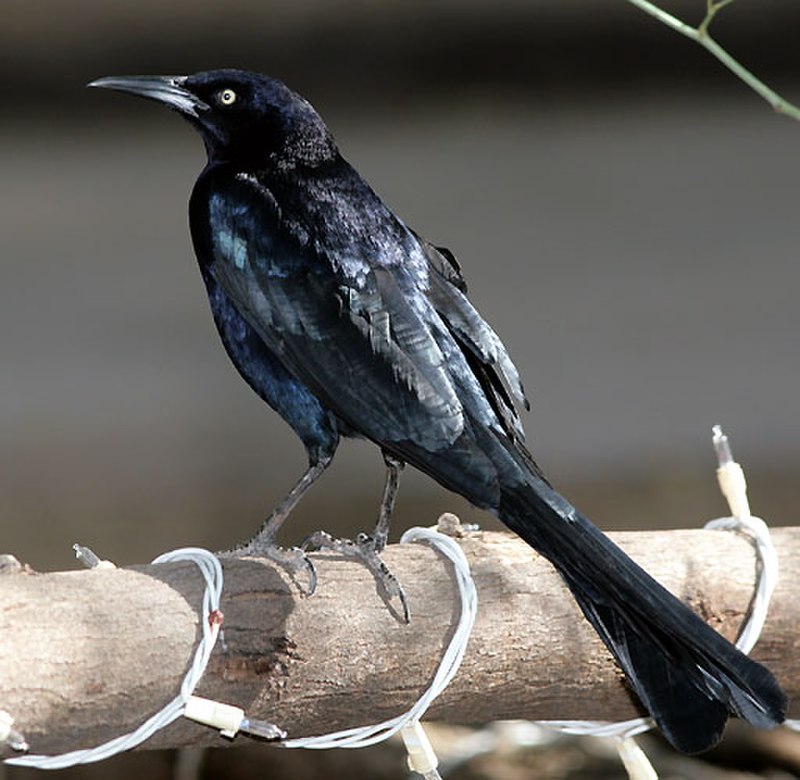
The Great-tailed Grackle is a medium sized bird native to North and South America. It belongs to the family Icteridae, making it closely related to two other species of grackles – the Boat-tailed and Slender-billed.
They are highly social birds which often appear in large flocks or colonies.
Their plumage ranges from glossy black with blue or purple iridescence, through brownish grey shades depending on location.
In some areas they have been known as “blackbirds” due their predominately dark colouring.
This adaptable species is also renowned for its distinctive long tail feathers – hence its name.Scientific classification:
| Kingdom | Animalia |
| Phylum | Chordata |
| Class | Aves |
| Order | Passeriformes |
| Family | Icteridae |
| Genus | Quiscalus |
| Species | Q. mexicanus |
Also Featured In: Top Birds Found in Mexico, Common San Antonio Birds
9. White-Winged Dove
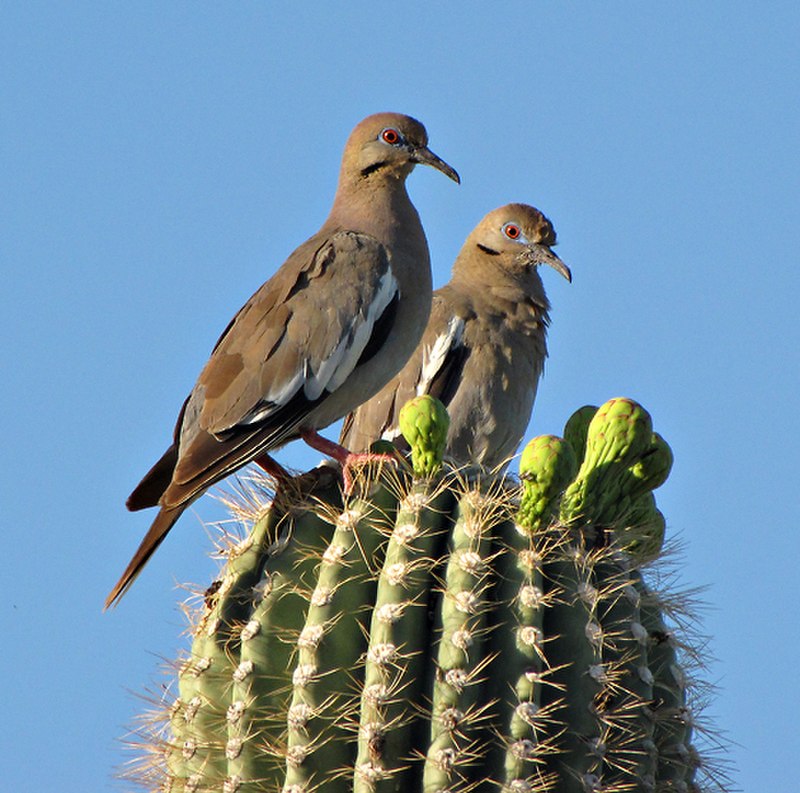
The White-winged Dove is an impressive bird with a large body and wingspan. Its distinctive feature is the white edge on its wings, which makes it easily recognizable when in flight.
It has blue eyerings, red eyes and gray plumage, while juveniles are duller in coloration than adults.
This dove species inhabits areas from Southwestern United States through Mexico to Central America as well as Caribbean islands.
They usually live close to human settlements or cities but can also be found in agricultural fields feeding on grains like corn or wheat seeds left by farmers after harvest season ends.
In their natural habitat they feed primarily on insects, fruits and small plants such as certain cacti species.Scientific classification:
| Kingdom | Animalia |
| Phylum | Chordata |
| Class | Aves |
| Order | Columbiformes |
| Family | Columbidae |
| Genus | Zenaida |
| Species | Z. asiatica |
Also Featured In: Common Birds of Houston, Small Birds of Texas
10. Inca Dove
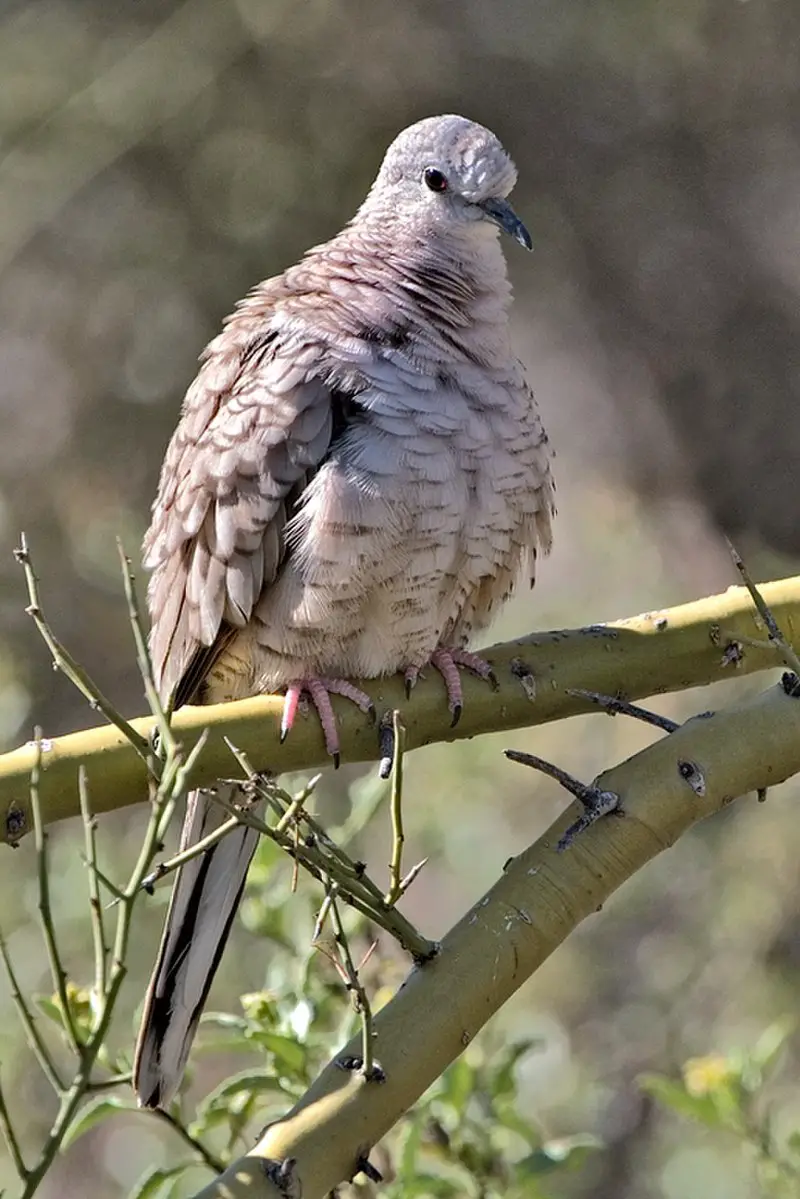
The Inca Dove is a small, slender bird found in the New World. It has an average length of 16.5–23 cm and weighs about 30-58 gm. Its wingspan measures around 28.5cm but can reach up to 32cm at max.
The body of this dove is grayish brown with feathers that are rounded off tips giving it a soft look overall.
This species was first described by French surgeon and naturalist René Lesson back in 1847 and since then have been living happily all over North America from Mexico through Texas to South Dakota, Kansas as well as parts of Arizona among others regions too.Scientific classification:
| Kingdom | Animalia |
| Phylum | Chordata |
| Class | Aves |
| Order | Columbiformes |
| Family | Columbidae |
| Genus | Columbina |
| Species | C. inca |
Also Featured In: Birds that You’ll Find in Chiapas, Birds that Live in Jalisco Birds
11. Broad-Billed Hummingbird
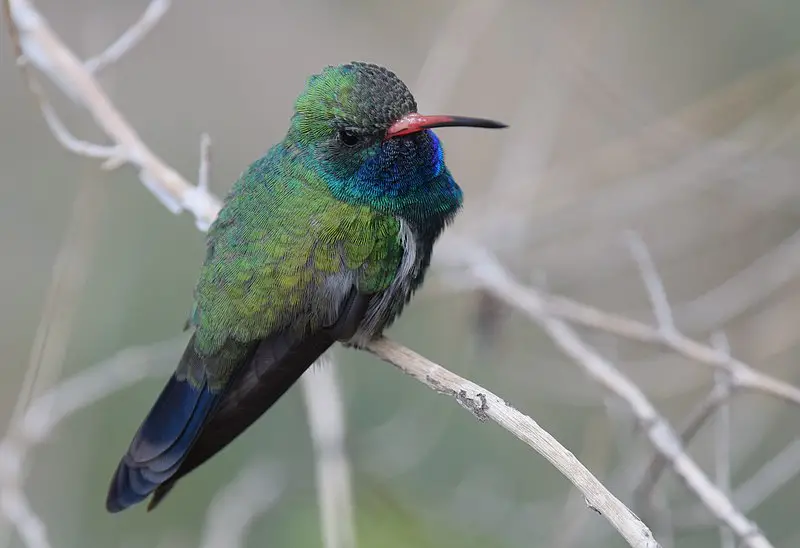
The Broad-billed Hummingbird is a small species of hummingbird that can be found in Mexico and the southwestern United States.
It has distinctive sexual dimorphism, with females resembling their juvenile counterparts more than males do.
This bird stands out thanks to its bright colors and broad, red bill. Other common names for this species include Colibri Mexicano (Spanish) or Mexican Hummingbird.
The Broad-billed usually nests on trees or shrubs near streams but may also occupy wooded areas or gardens close by human settlements during wintertime.
They feed mainly on nectar from flowers while supplementing their diet with insects depending on availability of prey items as well as seasonality changes throughout their range area.Scientific classification:
| Kingdom | Animalia |
| Phylum | Chordata |
| Class | Aves |
| Order | Apodiformes |
| Family | Trochilidae |
| Genus | Cynanthus |
| Species | C. latirostris |
Also Featured In: Summer Birds that Live around Us, Puerto Vallarta Birds You Should Know
12. Lesser Goldfinch
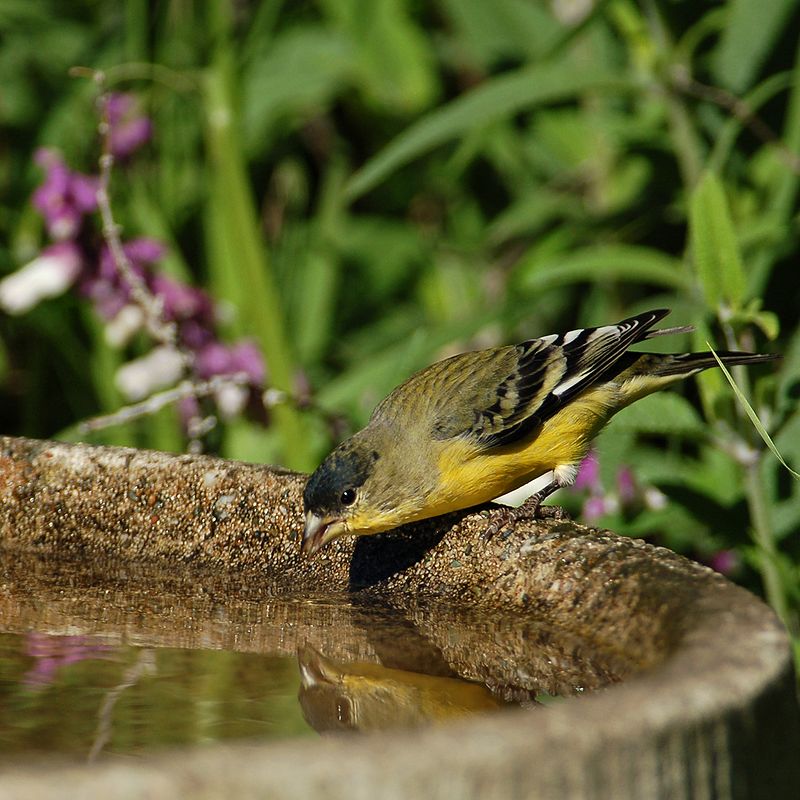
The Lesser Goldfinch is a tiny species of bird found in the Americas. It belongs to the same clade as American goldfinches and Lawrence’s goldfinches, which can be identified by their males having black or rarely green foreheads.
The face appears red or yellow on these birds unlike other species in its genus Spinus sensu stricto.
They are small songbirds with short bills, brown wings and tails with white edges, grey-brown backs and olive heads.
These birds inhabit open woodlands and fields where they feed mainly on seeds from weeds such as thistle, pigweed and ragweed but also consume insects at times during breeding season for additional nutrition.
In addition to being an important part of North America’s avian ecology, these birds have been popularized through recent artwork depicting them in various poses among flowers.Scientific classification:
| Kingdom | Animalia |
| Phylum | Chordata |
| Class | Aves |
| Order | Passeriformes |
| Family | Fringillidae |
| Subfamily | Carduelinae |
| Genus | Spinus |
| Species | S. psaltria |
Also Featured In: Birds that Live in San Francisco Bay Area, Birds that Live in Yosemite National Park
13. Ferruginous Pygmy Owl
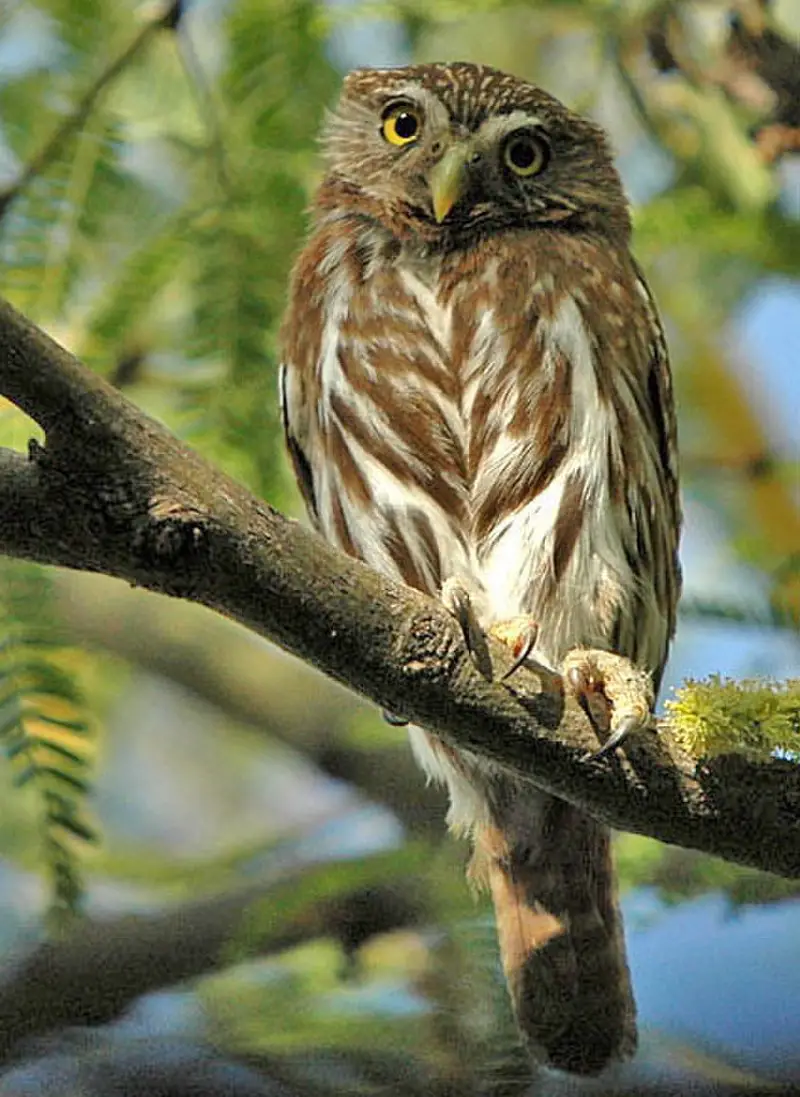
The ferruginous pygmy owl is a small species of owl that can be found throughout much of Central and South America, as well as parts of the United States.
It has rusty-brown feathers on its body, giving it an overall “ferruginous” colouration. The bird feeds mainly on insects and other invertebrates, but also eats some larger prey such as lizards or mice when available.
During breeding season the birds build nests in tree cavities to raise their young. They are usually nocturnal creatures but may become active during daylight hours if disturbed by humans or predators nearby.
This adaptable little raptor is often seen perching atop buildings or street lights in urban areas where they have adapted to live alongside human activity while still finding food sources within cities and townships alike.Scientific classification:
| Kingdom | Animalia |
| Phylum | Chordata |
| Class | Aves |
| Order | Strigiformes |
| Family | Strigidae |
| Genus | Glaucidium |
| Species | G. brasilianum |
Also Featured In: Uruguay birds,
14. Black-Tailed Gnatcatcher
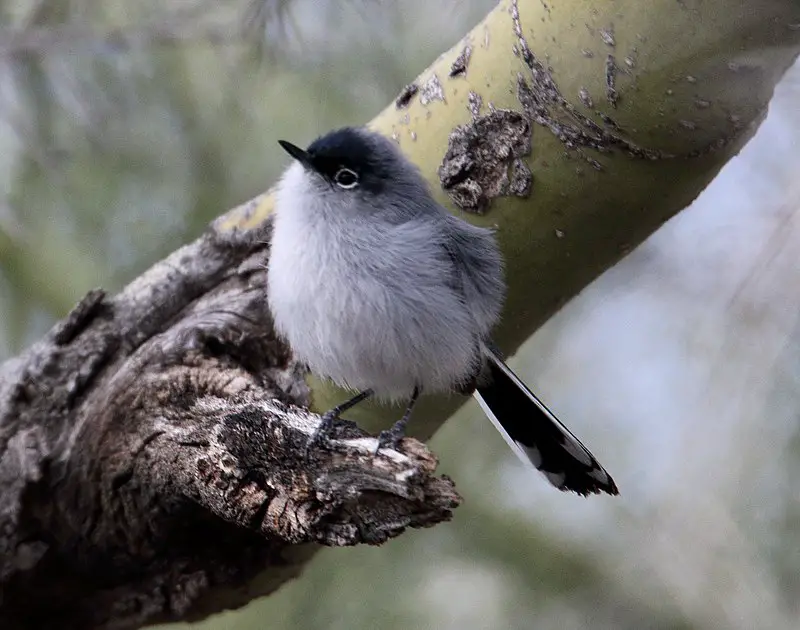
The Black-tailed Gnatcatcher is a small, insectivorous bird found in the Sonoran and Chihuahuan Deserts of North America. These birds do not migrate and can be seen year round in dry desert areas.
Described by American ornithologist George Newbold Lawrence in 1857, its scientific name (Polioptila melanura) translates to ‘black-tailed’.
It has an overall grayish brown plumage with white wingbars, black tail feathers, a long slender bill for catching insects on the fly and pale eyes lined with dark markings .
They are vocal birds that produce melodious song including trills, warbles and whistles often heard during breeding season from May through August.
The diet consists mainly of various insects such as flies , moths , beetles as well bugs which help control pest populations naturally making it an important species for our eco system.Scientific classification:
| Kingdom | Animalia |
| Phylum | Chordata |
| Class | Aves |
| Order | Passeriformes |
| Family | Polioptilidae |
| Genus | Polioptila |
| Species | P. melanura |
Also Featured In: Chickadees Birds, Birds that Live in the Deserts
15. Brown-Crested Flycatcher
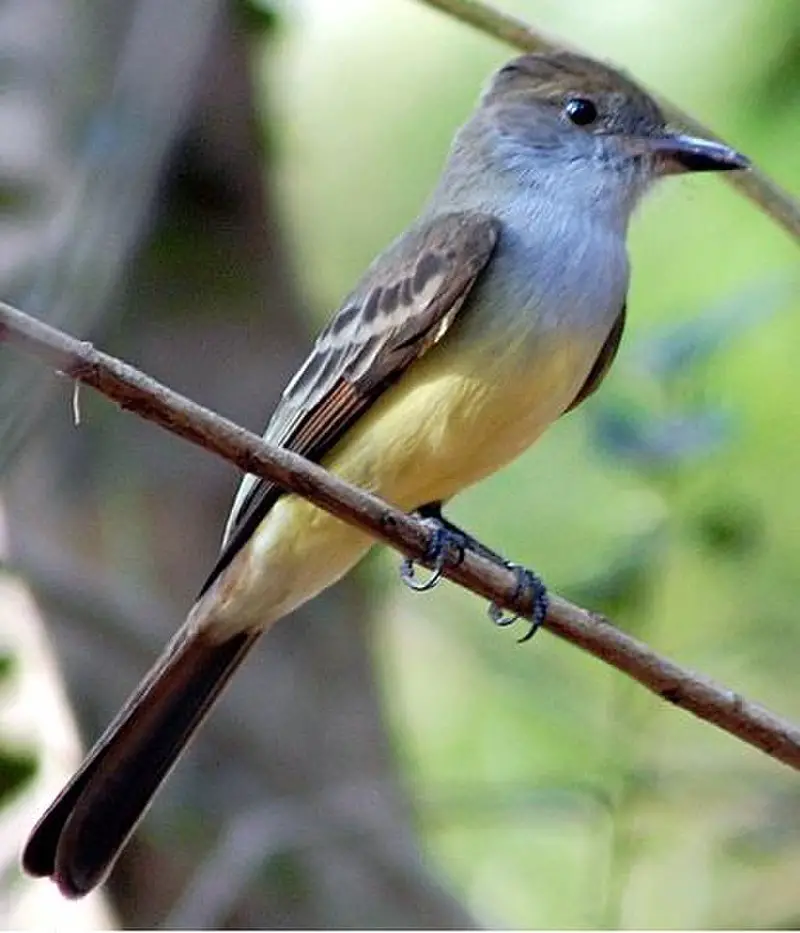
The Brown-crested Flycatcher is a passerine bird belonging to the tyrant flycatcher family. It’s one of the largest species in its genus, ranging from 18 to 24 cm in length and varying greatly in size across their range with those foundin M. t. tyrannulus typically being smaller than others like M. t magister.
These birds have brown upperparts and wings while they sport yellow undersides along with white bellies and throats as well as black tails and blueish purple bills which make them instantly recognisable among other types of birds around them.
They are also known for their loud calls that sound similar to “tek-tekk” or even “preeeit”.Scientific classification:
| Kingdom | Animalia |
| Phylum | Chordata |
| Class | Aves |
| Order | Passeriformes |
| Family | Tyrannidae |
| Genus | Myiarchus |
| Species | M. tyrannulus |
Also Featured In: Flycatchers Species, Birds that Live in Morelos
16. Black Phoebe
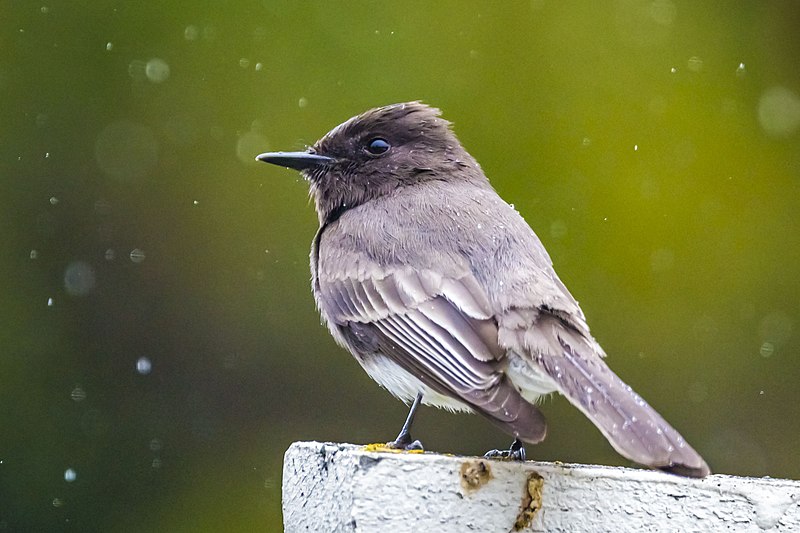
The black phoebe is a beautiful passerine bird belonging to the tyrant-flycatcher family. It breeds from southwest Oregon and California south through Central and South America, where it can be found year-round.
However, its northern populations tend to migrate seasonally in some areas. Six subspecies of this species have been identified so far: two are occasional visitors while the others are more common residents in their range.
The adult has mainly dark grey upperparts with a white belly; juveniles may show brownish tones instead of grey ones on their back.
Its main diet consists of insects which it catches by hovering over water or flying out after them from perches near rivers or streams – hence why they’re often seen around these places.Scientific classification:
| Kingdom | Animalia |
| Phylum | Chordata |
| Class | Aves |
| Order | Passeriformes |
| Family | Tyrannidae |
| Genus | Sayornis |
| Species | S. nigricans |
Also Featured In: Birds Live Near San Diego, Common Southern Californian Birds
17. Costa’s Hummingbird
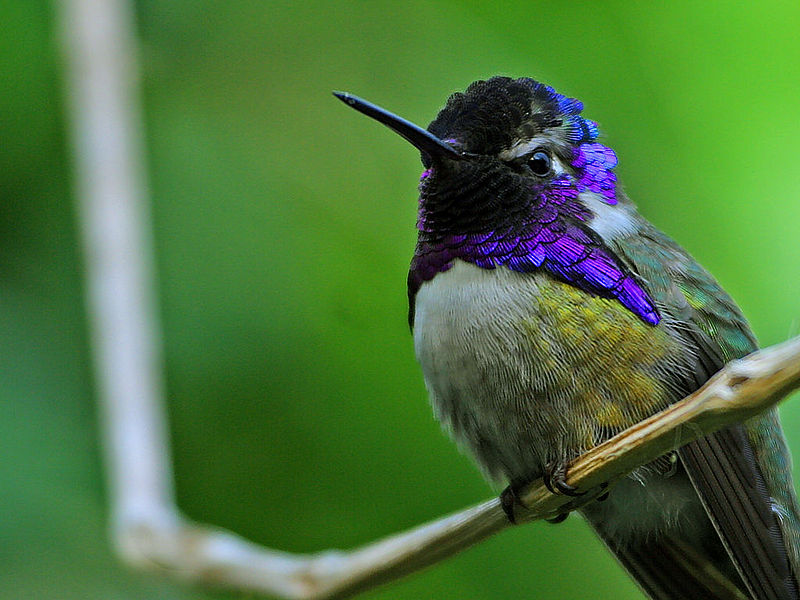
Costa’s hummingbird is a species of the Trochilidae family. It inhabits arid regions in both the southwest United States and northwest Mexico, migrating to western Mexico for wintering purposes.
This bird was named by French ornithologist Jules Bourcier in 1839 after honouring François Coste, who had sent specimens to him from North America.
Costa’s hummingbirds are small birds averaging 3-3.5 inches (7–9cm) long with typically green feathers on their back and tail while underparts are usually greyish or sometimes white with purple highlights around throat area giving them an iridescent appearance when light hits it right angle.
Males also have red patches on forehead which they use as part of courtship display behavior along with singing distinctive “wheep” sound during mating season.Scientific classification:
| Kingdom | Animalia |
| Phylum | Chordata |
| Class | Aves |
| Order | Apodiformes |
| Family | Trochilidae |
| Genus | Calypte |
| Species | C. costae |
Also Featured In: Hummingbirds Species, Phoenix Birds You Should Know
18. Western Screech Owl
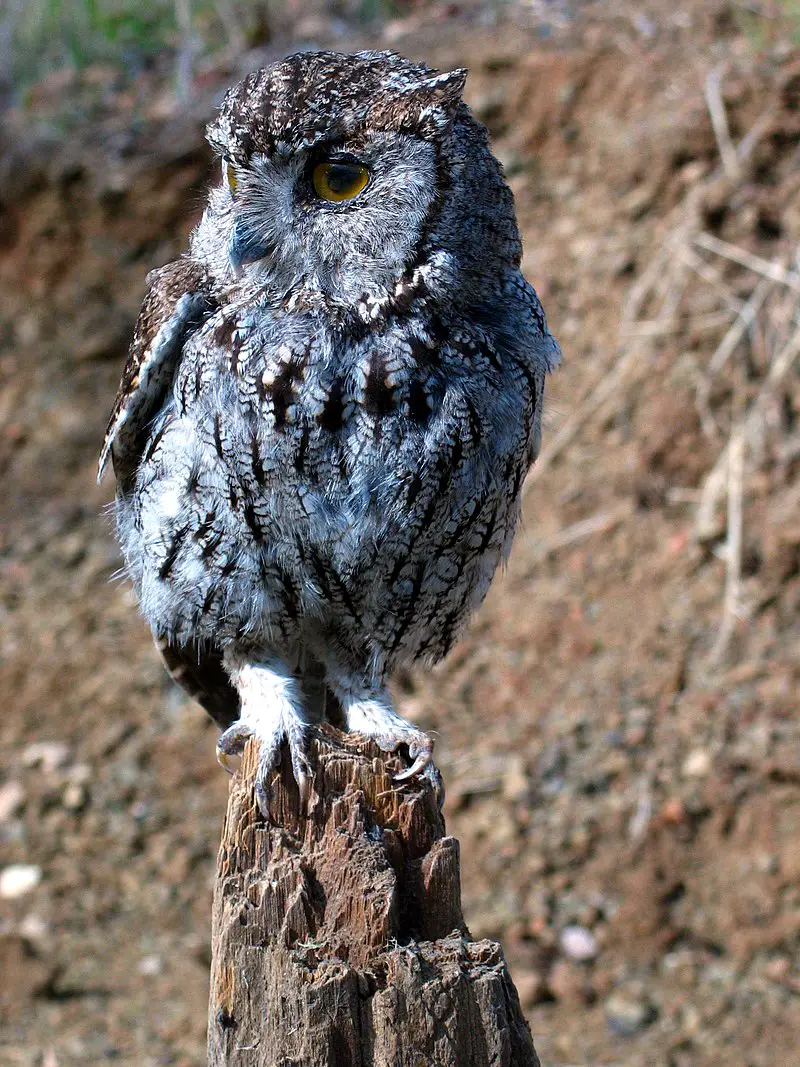
The Western Screech Owl is a small bird native to both North and Central America. It belongs to the same family as its Eastern counterpart, standing at an average of 22 cm tall with 55 cm wingspan and weighing about 143 g.
Females tend to be larger than males, while weight can range from 88-220g depending on habitats in Northern populations being heavier than those living further south.
The scientific name for this owl pays homage to American naturalist Robert Kennicott who studied these birds extensively during his life’s work.
Their diet mostly consists of invertebrates such as insects but they may also hunt small mammals when food sources are scarce or seasonally available.
Their habitat preferences vary across different parts of their geographical range due mainly to environmental conditions like climate and vegetation type.Scientific classification:
| Kingdom | Animalia |
| Phylum | Chordata |
| Class | Aves |
| Order | Strigiformes |
| Family | Strigidae |
| Genus | Megascops |
| Species | M. kennicottii |
Also Featured In: Owls Species, Birds You’ll Find in Night
19. Elf Owl
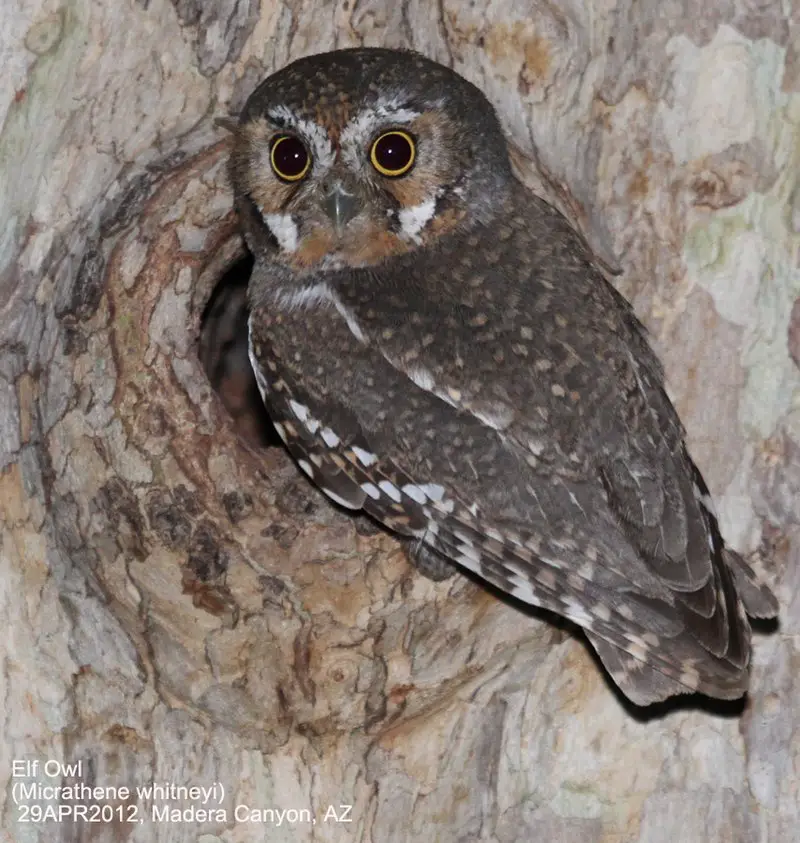
The Elf Owl is a small and fascinating bird. It’s grayish-brown in color, with pale yellow eyes that are highlighted by thin white “eyebrows” and a gray bill with a horn-colored tip.
This owl can be found throughout the Southwestern United States, central Mexico, and the Baja California peninsula.
These birds often take up residence in woodpecker holes inside saguaro cacti or natural tree cavities.
They’re nocturnal hunters who feed mainly on insects as well as other small prey such as lizards or rodents.
Despite their size they have impressive vocalizations that include whistles and harsh cries which helps them to communicate within their range during breeding season; however it also serves to alert predators of its presence.Scientific classification:
| Kingdom | Animalia |
| Phylum | Chordata |
| Class | Aves |
| Order | Strigiformes |
| Family | Strigidae |
| Genus | Micrathene Coues, 1866 |
| Species | M. whitneyi |
Also Featured In: Birds that Live in Arizona Desert,
20. Black-Throated Sparrow
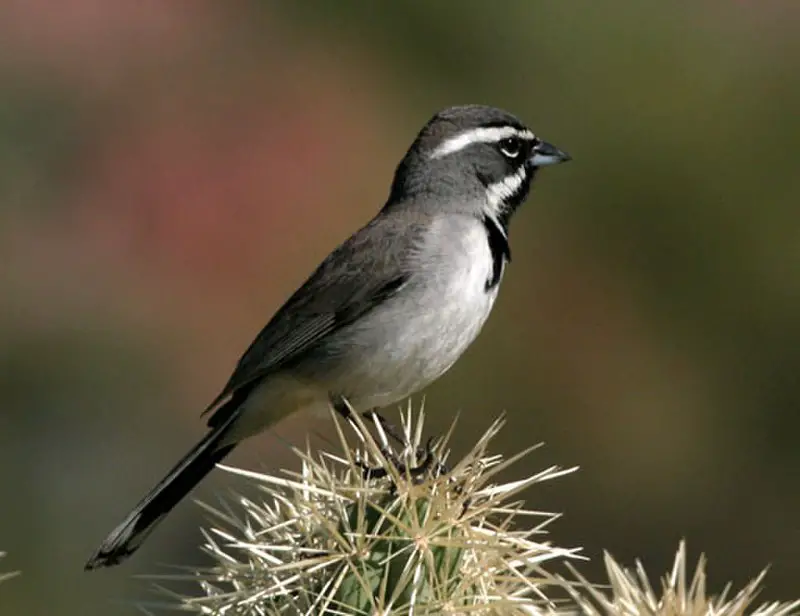
The black-throated sparrow is a small bird native to the southwestern United States and Mexico.
It is known for its striking features, including black throats with white stripes on either side as well as buffy, white underparts.
They are also recognized by their long tails and dark upper parts, which often have yellowish or rusty markings near the wings.
The birds prefer arid habitats such as deserts and scrublands; however they can be found in other areas too during migration periods.
These adaptable creatures feed on insects, seeds and grains from plants like grasses or cacti – making them an important species when it comes to sustaining healthy ecosystems.Scientific classification:
| Kingdom | Animalia |
| Phylum | Chordata |
| Class | Aves |
| Order | Passeriformes |
| Family | Passerellidae |
| Genus | Amphispiza Coues, 1874 |
| Species | A. bilineata |
Also Featured In: Sparrows Species,
21. Gila Woodpecker
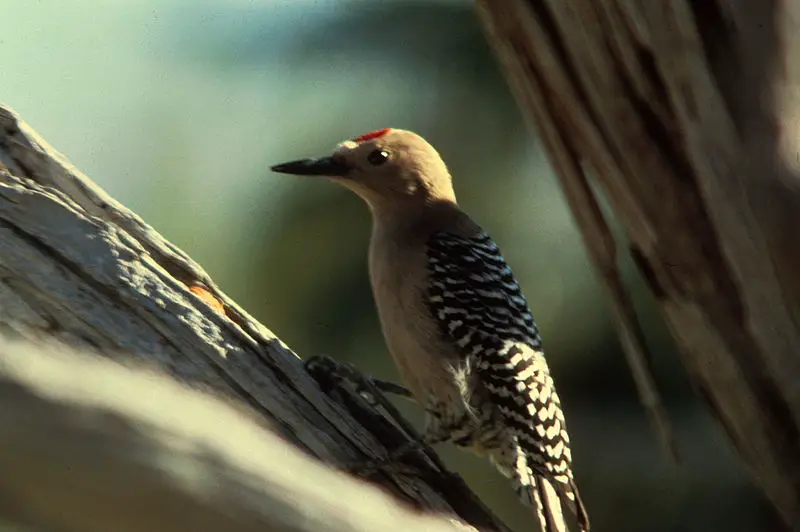
The Gila woodpecker is a medium-sized bird found in the desert regions of the southwestern United States and western Mexico.
It has a unique coloration, featuring black and white zebra-like stripes on its back, wings, and tail feathers.
Its neck, throat belly and head are greyish tan in color with small red or yellow spots on its nape.
They feed mainly on insects but have been known to eat berries when available during winter months.
These birds are social creatures that often nest together in large colonies to increase their chances of survival against predators such as hawks or owls.
The Gila woodpecker plays an important role in maintaining healthy ecosystems by eating destructive beetles while also spreading seeds from cacti they consume throughout the year.Scientific classification:
| Kingdom | Animalia |
| Phylum | Chordata |
| Class | Aves |
| Order | Piciformes |
| Family | Picidae |
| Genus | Melanerpes |
| Species | M. uropygialis |
Also Featured In: Woodpeckers Species,
22. Gilded Flicker
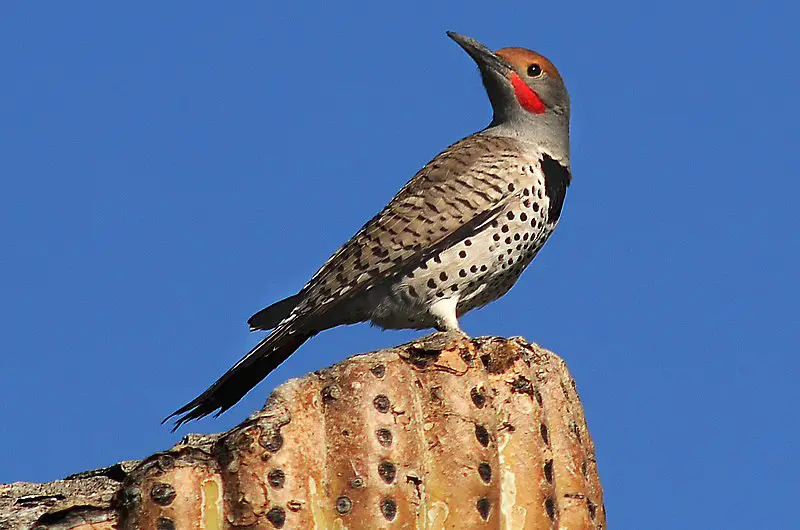
The Gilded Flicker is an impressive and striking bird that can be found in the desert regions of Southwestern United States and Northwestern Mexico.
It has a mean length of 29 cm (11 inches) which makes it one of the largest woodpeckers.
Its distinguishing feature is its golden-yellow underwings, making it stand out from other species such as the northern flicker in these areas.
This majestic bird mainly consumes insects but may also feed on fruits or berries when available, helping to spread seeds throughout their habitats.
As they are not migratory birds, they remain all year round; hence providing some stability to their local ecosystems.Scientific classification:
| Kingdom | Animalia |
| Phylum | Chordata |
| Class | Aves |
| Order | Piciformes |
| Family | Picidae |
| Genus | Colaptes |
| Species | C. chrysoides |
Also Featured In: Yellow Birds of Arizona,
23. Canyon Wren
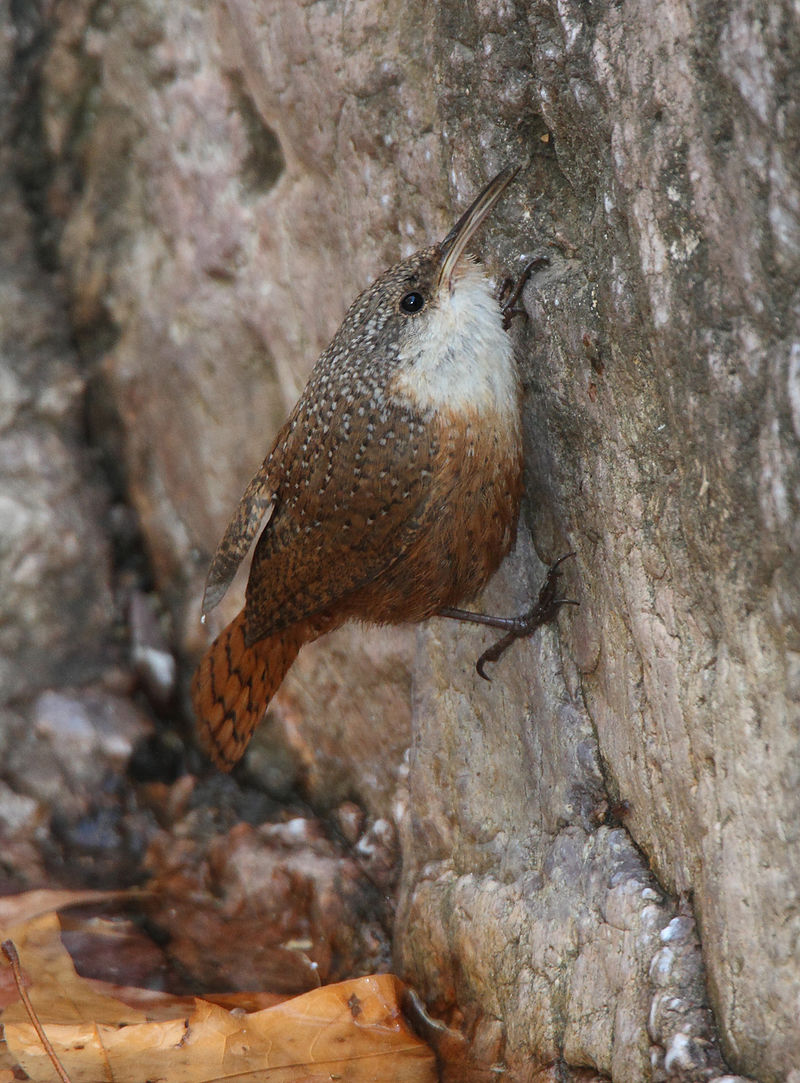
The Canyon Wren is a small songbird that belongs to the wren family, Troglodytidae. It’s native to North America and lives mainly in rocky or arid areas such as cliffs and canyons.
A distinct feature of this bird is its loud song which echoes through the canyon walls – it can be heard from far away.
The Canyon Wren has adapted well to its environment; with drab coloring helping it blend into the rocks, camouflaging itself from predators.
Its diet consists mainly of insects, spiders and snails found on cliff faces or in crevices between rocks.
As there are no other species within its taxon, they do not have any major threats aside from natural occurrences like avalanches or rock slides that could cause habitat loss for them.Scientific classification:
| Kingdom | Animalia |
| Phylum | Chordata |
| Class | Aves |
| Order | Passeriformes |
| Family | Troglodytidae |
| Genus | Catherpes Baird, 1858 |
| Species | C. mexicanus |
Also Featured In: Wrens Species, Most Common Songs Birds that Live around You
24. Yellow-Headed Blackbird
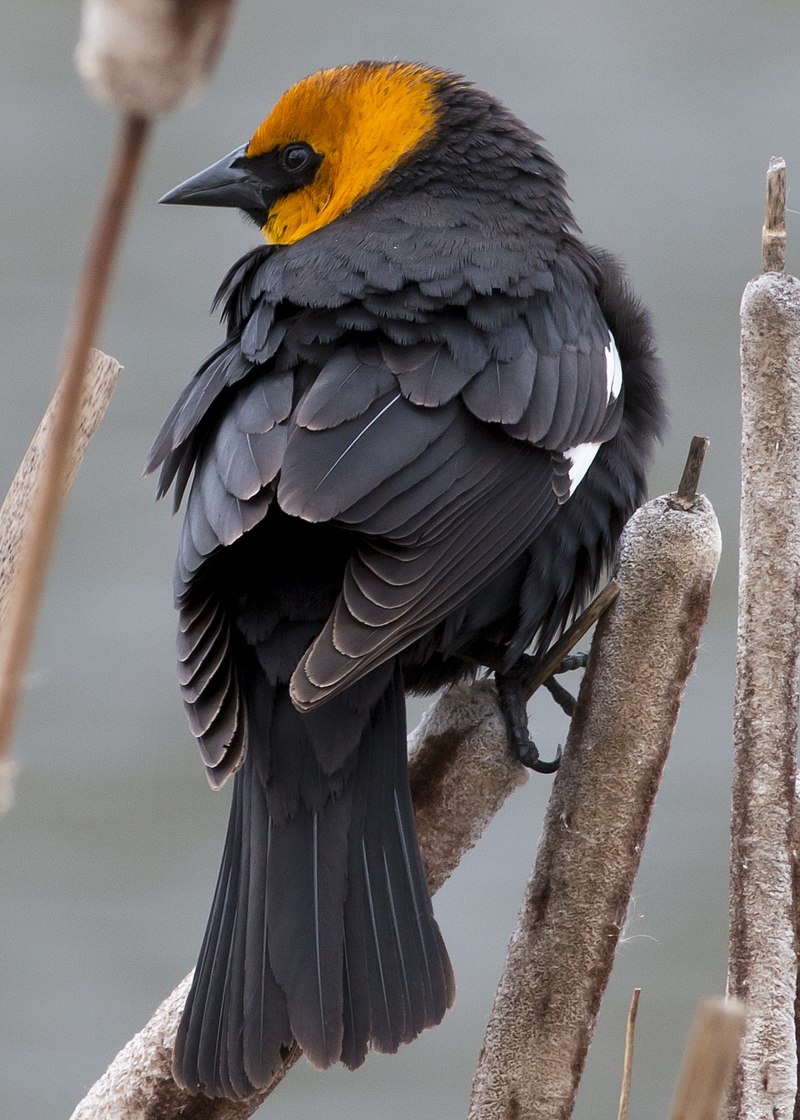
The yellow-headed blackbird is a medium-sized bird with striking features – its head and neck are bright yellow, while the rest of its body is black.
It has large eyes, a pointed bill and long wings that help it to soar through the air.
The species gets its name from Greek words meaning ‘yellow’ (xanthous) and ‘head’ (cephalus).
This species can be found in wetlands across North America during summer months where they feed on insects and other invertebrates such as snails, earthworms, spiders and crustaceans.
During winter months they migrate southward for food or when temperatures drop too low for their comfort.
They also form flocks which makes them more visible than solitary birds like hawks or owls. Yellow-headed Blackbirds make beautiful sounds that echo around wetland areas; these melodic calls bring joy to many nature lovers.Scientific classification:
| Kingdom | Animalia |
| Phylum | Chordata |
| Class | Aves |
| Order | Passeriformes |
| Family | Icteridae |
| Genus | Xanthocephalus Bonaparte, 1850 |
| Species | X. xanthocephalus |
Also Featured In: Utah Birds, Birds Live in Arkansas
25. Verdin
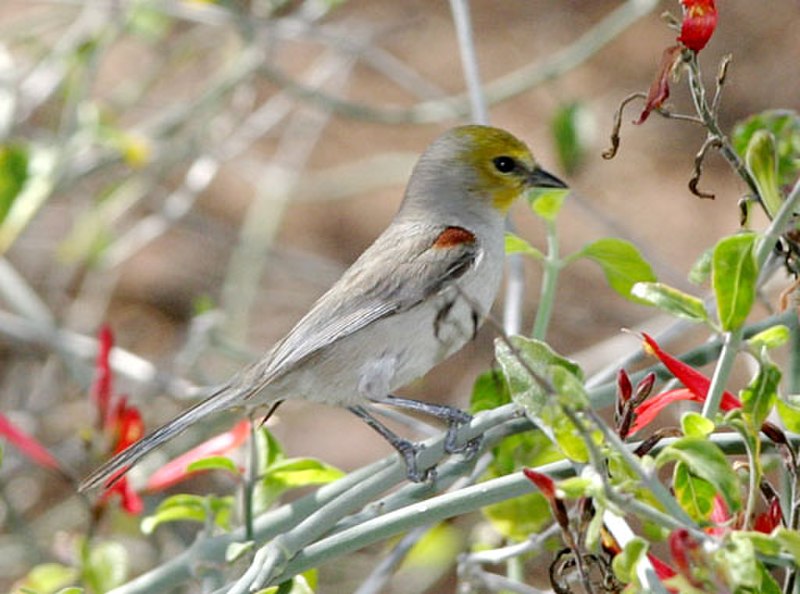
Verdin is a species of penduline tit, the only one in its genus Auriparus and family Remizidae found in North America.
It was formally described by Swedish zoologist Carl Jakob Sundevall under the binomial name Aegithalus flaviceps in 1850.
This small bird has an olive-grey coloration on its head, back and wings while having white colouring around its face with yellowish patches near eyes.
The underside is pale grey with brown tinge while feet are pinkish/brown tinted. Its diet consists mainly of insects which it forages from tree branches or shrubs.
During mating season they build intricate nests made up of grasses and moss lined inside with feathers or fur held together by spider webs usually suspended from thorny trees close to water sources like rivers or streams making them ideal for rearing young chicks before their migration towards south during winter months.Scientific classification:
| Kingdom | Animalia |
| Phylum | Chordata |
| Class | Aves |
| Order | Passeriformes |
| Family | Remizidae |
| Genus | Auriparus S.F. Baird, 1864 |
| Species | A. flaviceps |
Also Featured In: birds of Arizona, Common Birds That Live in Las Vegas
26. Curve-Billed Thrasher
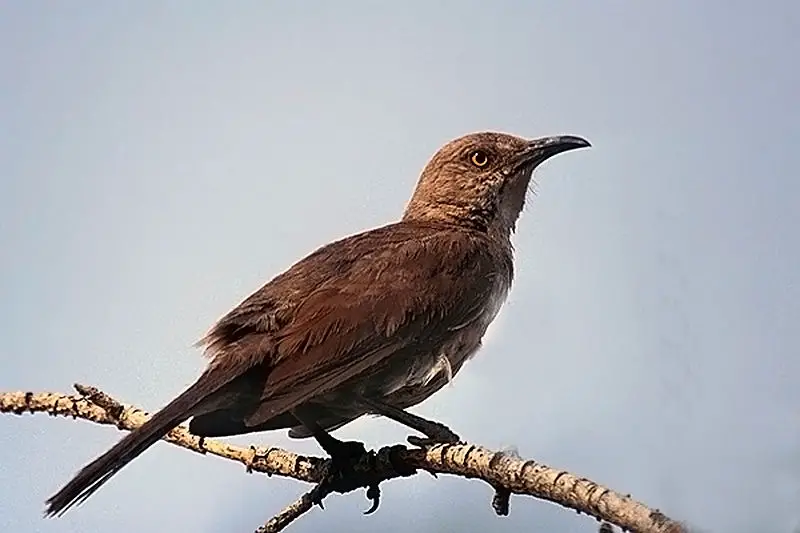
The Curve-billed Thrasher is a medium-sized bird native to Mexico and the southwestern United States. It lives mainly in desert areas, where it can be found foraging on the ground for its insect prey.
Its name comes from its curved bill, which aids in rooting out insects and other food sources.
The species has several subspecies that are geographically separated throughout much of their range; allopatric speciation likely played an important role here as well.
Despite being non-migratory, this thrasher will sometimes travel long distances when resources become scarce or during courtship displays with potential mates.
A successful predator of grasshoppers, beetles and other arthropods, the Curve-billed Thrasher plays an essential role in maintaining healthy ecosystems by controlling pest populations.Scientific classification:
| Kingdom | Animalia |
| Phylum | Chordata |
| Class | Aves |
| Order | Passeriformes |
| Family | Mimidae |
| Genus | Toxostoma |
| Species | T. curvirostre |
Also Featured In: Birds You’ll Find in South Texas , Birds You’ll Find in the Rio Grande Valley
27. Gambel’s Quail
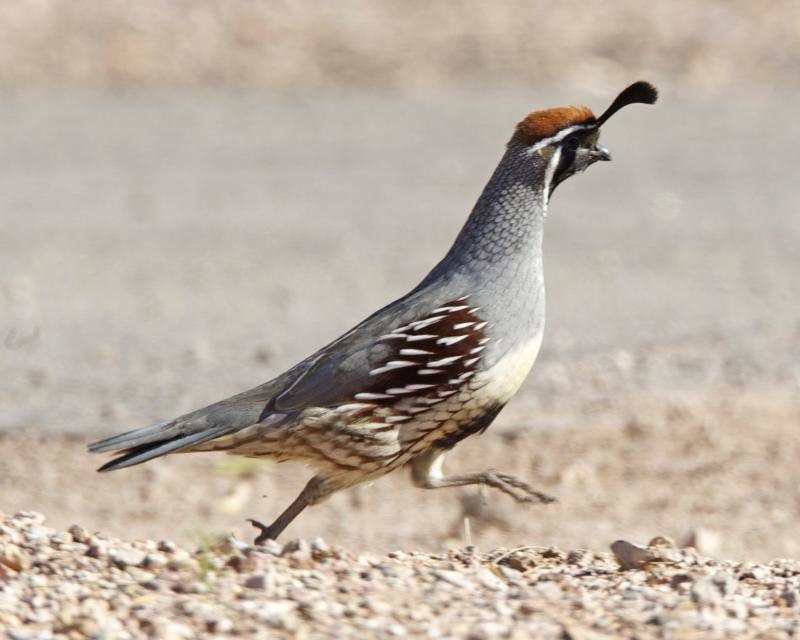
Gambel’s quail is a small bird belonging to the New World Quail family, found in desert regions of Arizona, California and other states. These birds inhabit dry areas with sparse vegetation such as cacti and shrubs.
They are named after William Gambel who explored much of the Southwestern United States during his lifetime.
This species has gray plumage on its body with a white underside and an eye-catching black plume that lies flat against their head when not displaying or calling out for mates during breeding season.
During these times they will also form large coveys (groups) which can range from 10 – 40 individuals.
When alarmed this group usually hides under nearby brush until danger passes – making them difficult to spot even in open terrain due to their camouflage coloration.Scientific classification:
| Kingdom | Animalia |
| Phylum | Chordata |
| Class | Aves |
| Order | Galliformes |
| Family | Odontophoridae |
| Genus | Callipepla |
| Species | C. gambelii |
28. Pyrrhuloxia
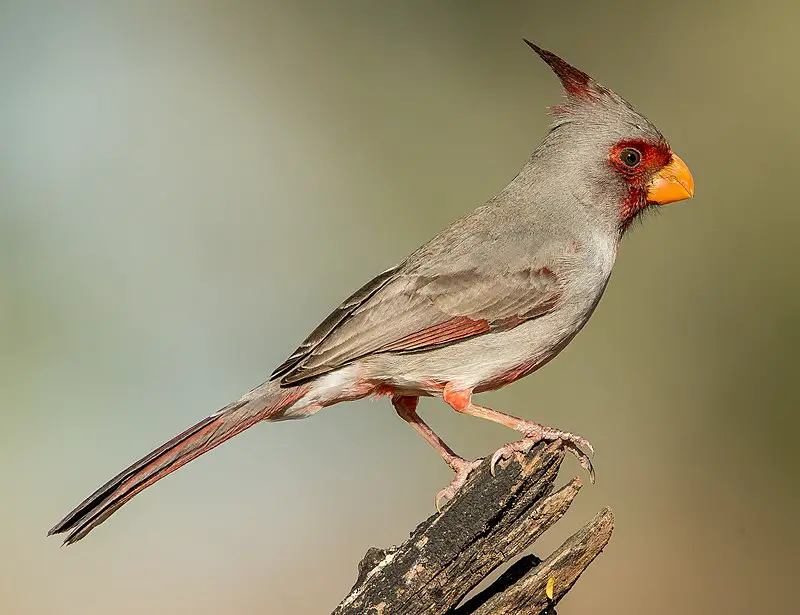
The Pyrrhuloxia, also known as the desert cardinal, is a stunningly beautiful bird native to the American Southwest and northern Mexico.
With its red crest and wings, short stout bill, it closely resembles the Northern Cardinal and Vermilion Cardinal of its same genus.
It has an average size compared to other songbirds in this area at around 18cm long with a wingspan of up to 28 cm wide.
Its diet mainly consists of small insects such as grasshoppers but they will occasionally eat some fruit or seeds too.
The Pyrrhuloxia’s singing ability rivals many birds in that region due to their clear whistles which can be heard from afar on quiet mornings.
The beauty of these birds makes them very popular among birdwatchers who come from all over just for a chance glimpse of one.Scientific classification:
| Kingdom | Animalia |
| Phylum | Chordata |
| Class | Aves |
| Order | Passeriformes |
| Family | Cardinalidae |
| Genus | Cardinalis |
| Species | C. sinuatus |
Also Featured In: Red birds You’ll See in Arizona, Red Birds You’ll See in Oklahoma
29. Phainopepla
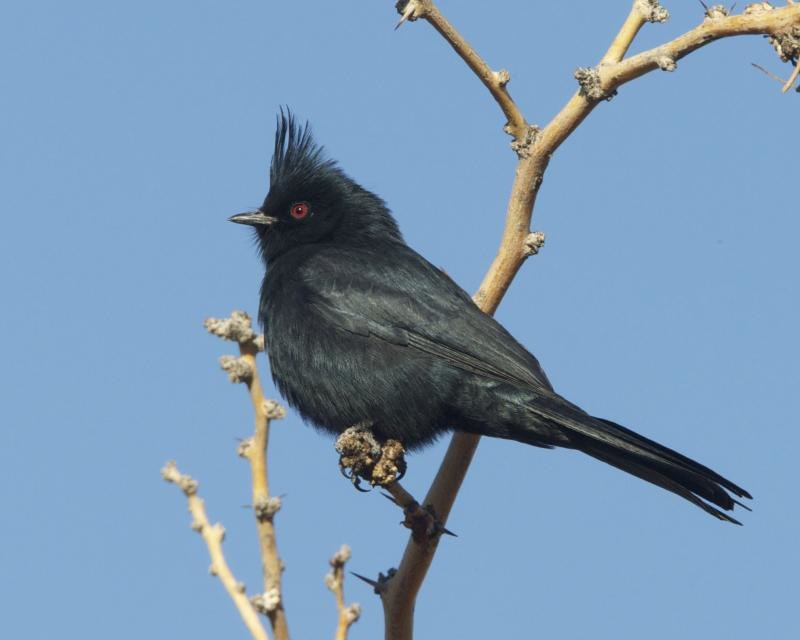
The Phainopepla bird is a stunning species to behold. It has an iridescent black plumage and stands at 16-20 cm long with a noticeable crest and long tail, giving it the appearance of wearing a ‘shining robe’.
This species belongs to the mainly tropical Central American family Ptiliogonatidae, which are known as silky flycatchers.
Its name derives from Greek origin meaning ‘shining robe’ in reference to its distinctive male plumage.
The phainopepla is natively distributed throughout North America, where they inhabit areas such as open woodlands and deserts that provide ample food sources like fruits or insects.
As fascinating birds of prey they have some interesting habits; for example they will often use their beaks to pry off bark while searching for tasty morsels beneath.Scientific classification:
| Kingdom | Animalia |
| Phylum | Chordata |
| Class | Aves |
| Order | Passeriformes |
| Family | Ptiliogonatidae |
| Genus | Phainopepla S.F. Baird, 1858 |
| Species | P. nitens |
30. Lesser Nighthawk
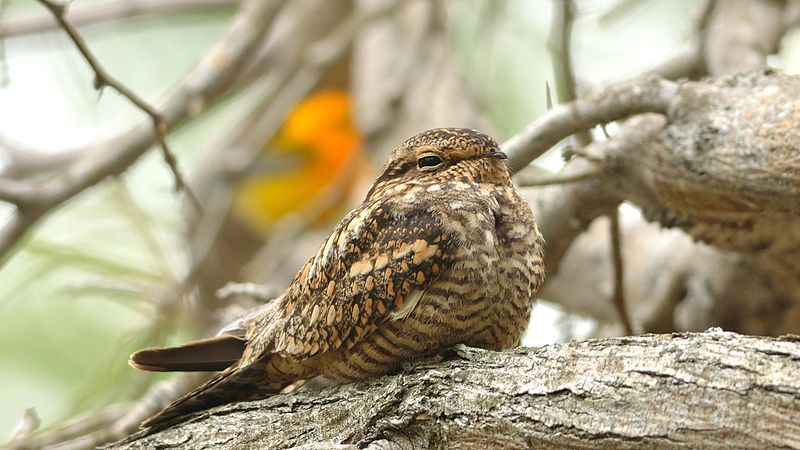
The Lesser Nighthawk is a nocturnal bird found across the Americas. Its dark brown and grey body has white patterning, while its long upper wings are black with a distinctive white bar visible in flight.
The tail is also black with thin white bars, while the underside of its body is buffy-coloured and finely streaked with horizontal lines.
Males have a bright white throat while females don’t; they both share an orange eye rim to complete their look.
During mating season males can be seen performing display flights at dusk over open areas like grasslands or riverbanks to impress potential mates.Scientific classification:
| Kingdom | Animalia |
| Phylum | Chordata |
| Class | Aves |
| Order | Caprimulgiformes |
| Family | Caprimulgidae |
| Genus | Chordeiles |
| Species | C. acutipennis |
Also Featured In: Most Common Birds in Michoacán,
31. Scott’s Oriole
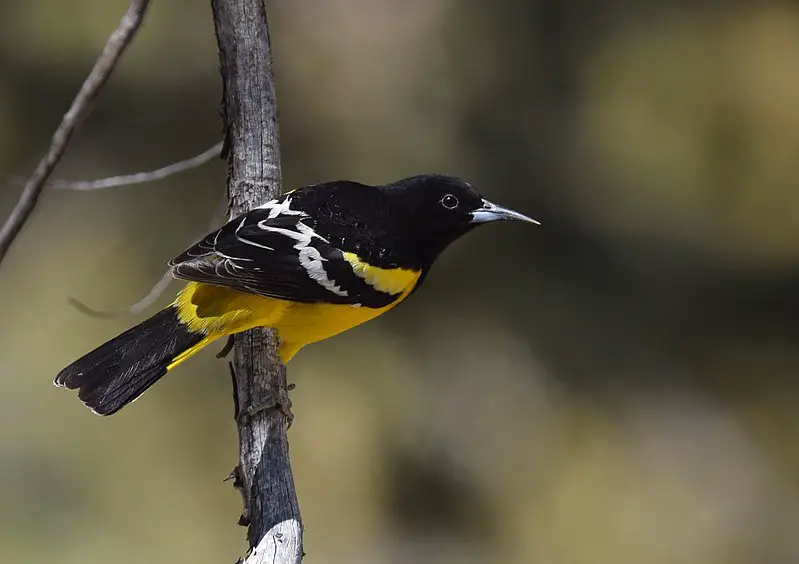
The Scott’s oriole is a medium-sized icterid found in the Southwestern United States, Mexico and Baja California Sur. Named by American soldier and naturalist John Charles Frémont for his friend Robert F.
Scott, this beautiful bird has bright yellow underparts with an orange back and black wings.
Its song consists of long series of whistles that are often likened to the sound of a flute or piccolo.
They feed mainly on insects but can also eat some fruits such as dates and figs from trees like mesquite, palo verde, live oak, sycamore and cottonwood.
This species is common south from Sacramento in California making it easy to spot if you’re lucky enough to be near its habitat.Scientific classification:
| Kingdom | Animalia |
| Phylum | Chordata |
| Class | Aves |
| Order | Passeriformes |
| Family | Icteridae |
| Genus | Icterus |
| Species | I. parisorum |
Also Featured In: birds of Nevada, Common Yellow Birds of Idaho
32. Rosy-Faced Lovebird
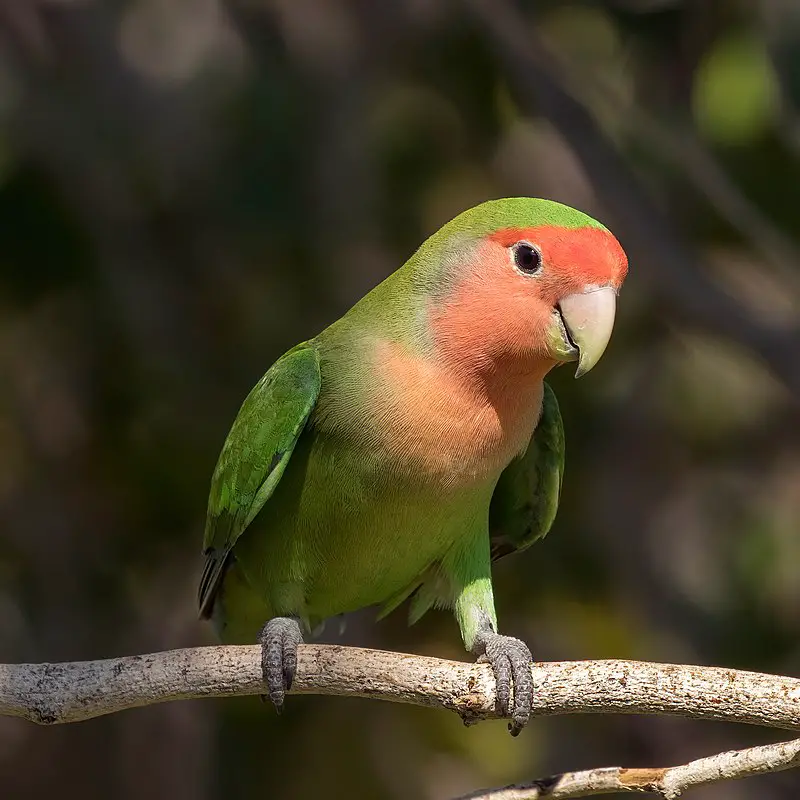
The Rosy-faced Lovebird is a vibrant and social species of bird native to arid regions in southwestern Africa. These small birds are known for their loud chirps which often come as part of large groups in the wild.
They also have wide variation between individuals when it comes to coloration, with some having more rosy hues on their faces than others.
Rosy-faced lovebirds eat throughout the day and enjoy frequent baths – they get most active during sunset where they fly around looking for food or interacting with other members of its flock.
It’s not uncommon to see these little birds playing games amongst themselves.
In captivity, they make wonderful pets due to their intelligence, friendliness and need for companionship from humans or other animals alike; making them great fits into any home environmentScientific classification:
| Kingdom | Animalia |
| Phylum | Chordata |
| Class | Aves |
| Order | Psittaciformes |
| Family | Psittaculidae |
| Genus | Agapornis |
| Species | A. roseicollis |
Also Featured In: birds of green birds, Case Birds that Live in with Us
33. Gray Vireo
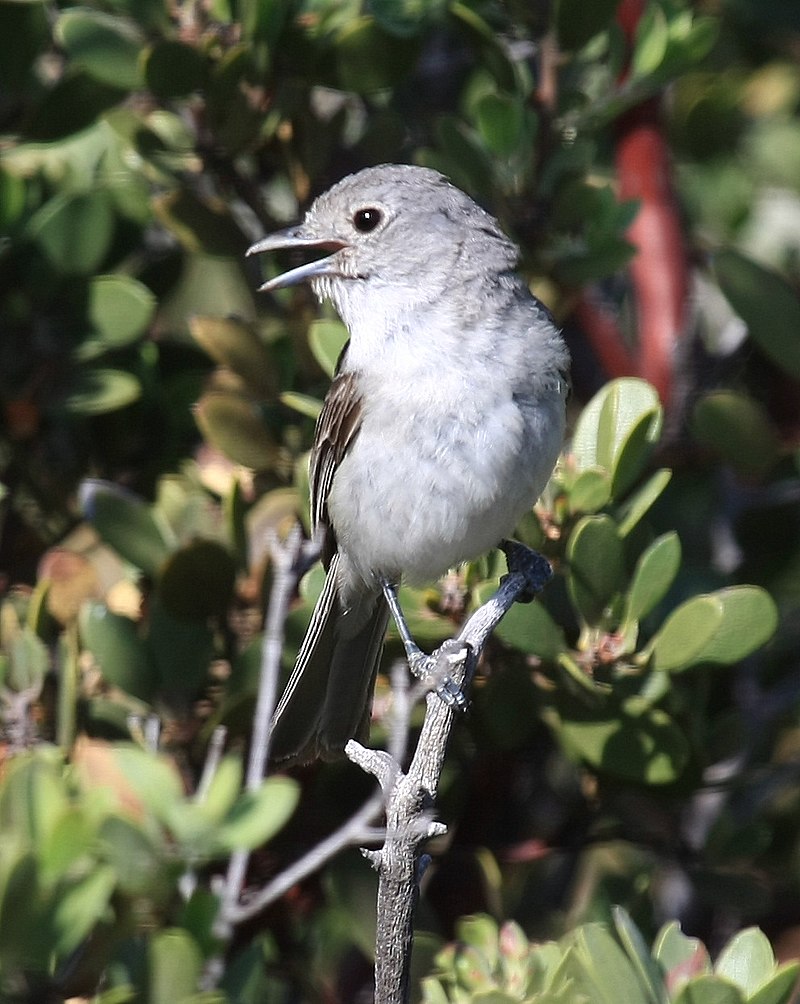
The Gray Vireo is a small North American passerine bird, found primarily in the southwestern United States and northern Baja California.
It has an annual migration, wintering in northwestern Mexico and remaining year-round only at Big Bend National Park in Texas.
This species prefers to live at higher altitudes of up to 2000 m and can be identified by its gray head with white streaks on its neck as well as yellowish sides.
Its diet consists mainly of insects which it finds while foraging through trees or shrubs; they also feed on berries during certain times of the year.
The male sings a complex song used to attract mates during breeding season from late April until July when eggs are laid.
These birds have strong family bonds throughout their lives making them highly social creatures that group together often to perform acrobatic aerial displays.Scientific classification:
| Kingdom | Animalia |
| Phylum | Chordata |
| Class | Aves |
| Order | Passeriformes |
| Family | Vireonidae |
| Genus | Vireo |
| Species | V. vicinior |
Also Featured In: birds of gray,
34. Mexican Jay
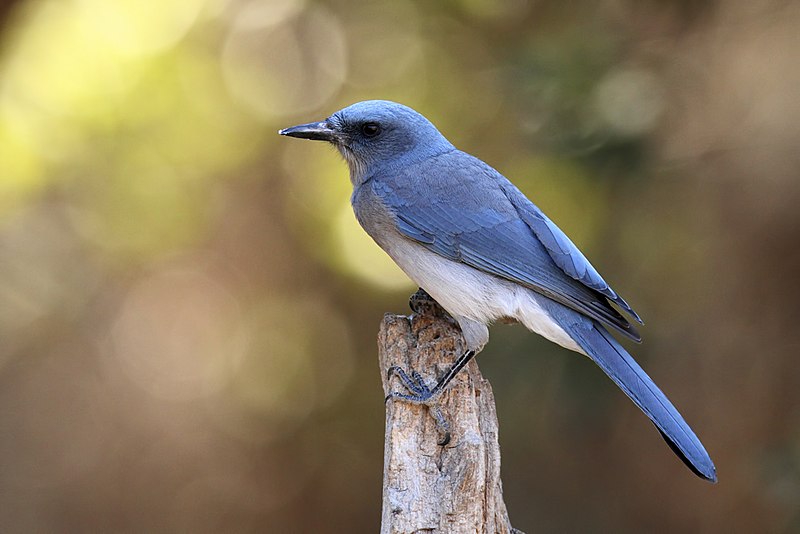
The Mexican jay, previously known as the gray-breasted jay, is a species of New World jay native to regions including the Sierra Madre Oriental, Sierra Madre Occidental, and Central Plateau of Mexico.
It also inhabits select areas in the southwestern United States. The Mexican jay was recently split into two species, with the other being known as the Transvolcanic jay.
These birds are known for their striking blue plumage and are often found in small groups.
They are opportunistic feeders, consuming a wide variety of food, including insects, fruits, seeds, and even small vertebrates.
The Mexican jay’s habitat includes woodlands, forests, and desert scrub. Due to habitat loss and fragmentation, their population is slowly declining, making them a conservation concern.Scientific classification:
| Kingdom | Animalia |
| Phylum | Chordata |
| Class | Aves |
| Order | Passeriformes |
| Family | Corvidae |
| Genus | Aphelocoma |
| Species | A. wollweberi |
Also Featured In: Blue Birds You’ll Found around Us, Most Common Birds of Nuevo Leon
35. Crissal Thrasher
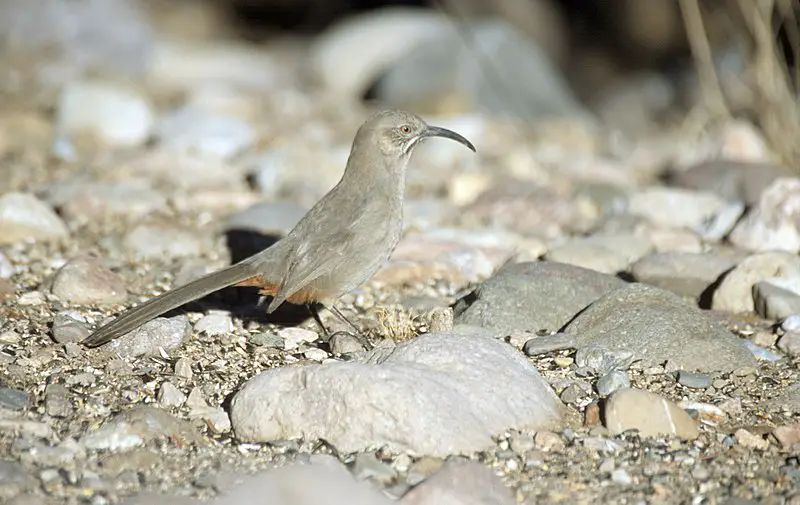
The Crissal thrasher is a sizeable bird that can be found in the Southwestern region of the United States and central Mexico.
It can grow up to 32 centimeters in length and is easily recognizable by its curved beak and dull yellow eyes.
It is a member of the thrasher family and is known for its distinctive singing voice.
The Crissal thrasher prefers to live in dense, thorny vegetation and can often be found in desert habitats. It feeds primarily on insects, but also eats fruits and small vertebrates.
Despite being a common bird in its range, the Crissal thrasher is somewhat elusive and can be difficult to spot due to its tendency to stay hidden in dense brush.
Bird enthusiasts consider the Crissal thrasher to be a beloved and impressive species due to its unique features and behavior.Scientific classification:
| Kingdom | Animalia |
| Phylum | Chordata |
| Class | Aves |
| Order | Passeriformes |
| Family | Mimidae |
| Genus | Toxostoma |
| Species | T. crissale |
36. Buteos
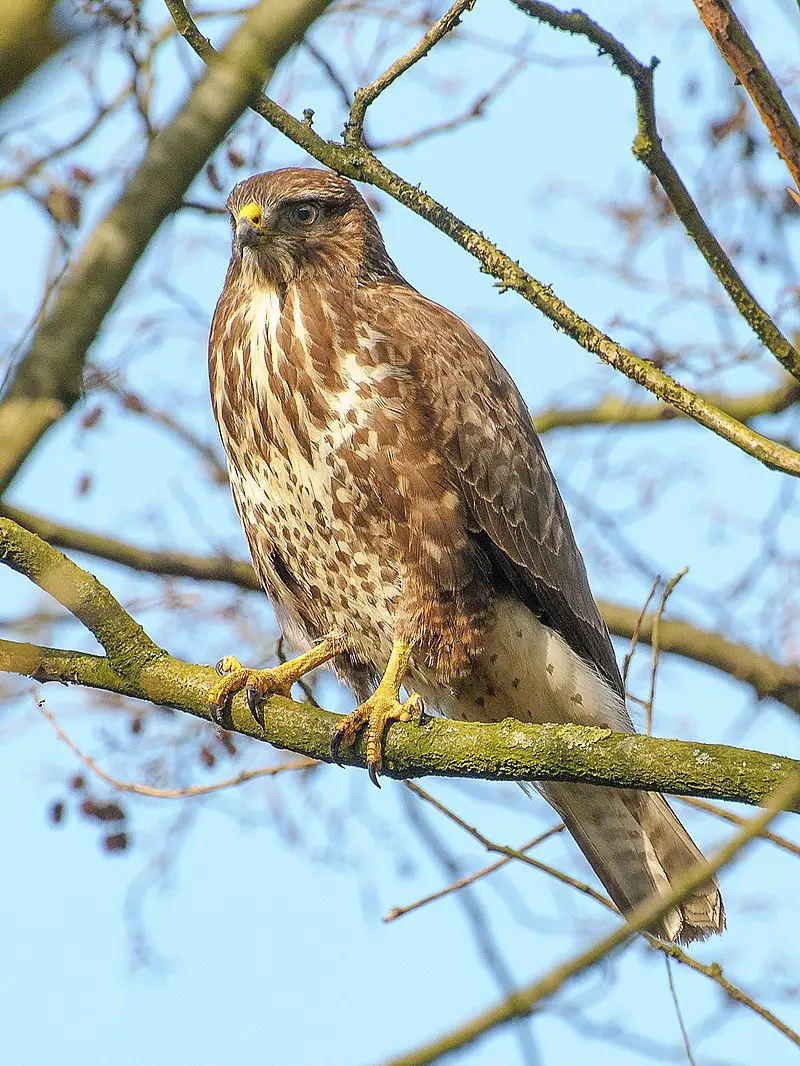
Buteos are robust-bodied birds of prey with broad wings that belong to the genus Buteo. The term “buzzard” is commonly used for members of this genus in the Old World, whereas “hawk” is used in the New World.
However, both terms are ambiguous, and some organizations prefer to use the Latin name of the common buzzard, Buteo, to avoid confusion.
Buteos are medium to fairly large birds, known for their powerful flying abilities and hunting skills.
These raptors are wide-ranging and can be found in a variety of habitats, including open grasslands, forests, and coastal areas.
Overall, Buteos are fascinating birds that play an important role in maintaining the ecological balance of their ecosystems.Scientific classification:
| Kingdom | Animalia |
| Phylum | Chordata |
| Class | Aves |
| Order | Accipitriformes |
| Family | Accipitridae |
| Subfamily | Buteoninae |
| Genus | Buteo Lacépède, 1799 |
Also Featured In: Birds of Côte d’Ivoire,
37. Vermilion Flycatcher
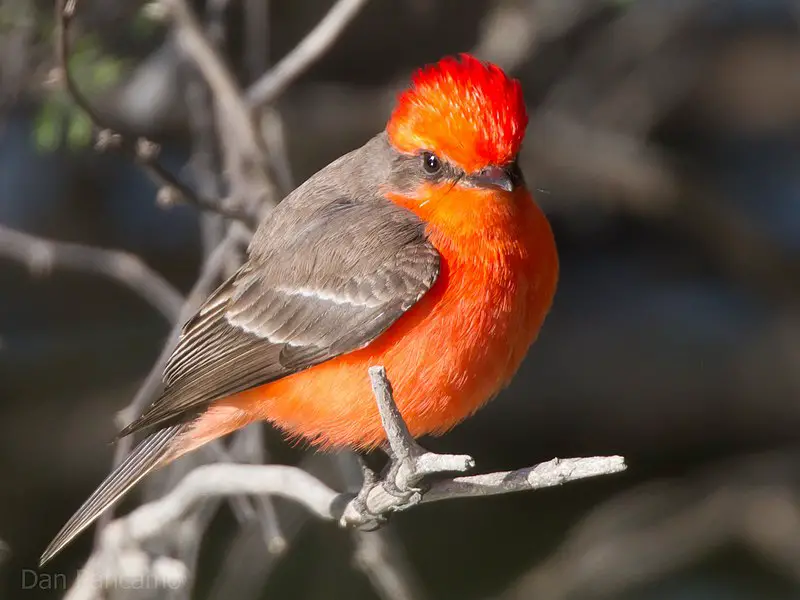
The Vermilion flycatcher is a colorful bird from the tyrant flycatcher family, typically found in South America and southern North America.
With its bright red crown, chest, and underparts, the male is a striking exception among its generally drab relatives.
The female lacks the vivid red coloration of the male, but displays earthy brown wings and tail. As a passerine bird, the Vermilion flycatcher feeds on insects by catching them in midair.
These birds are known for their distinctive “whit” calls, and can be spotted in a variety of habitats, from deserts to forests.
Their numbers appear to be stable, although local populations may be vulnerable due to habitat destruction.
Despite its small size, the Vermilion flycatcher is a memorable and distinctive addition to the avian world.Scientific classification:
| Kingdom | Animalia |
| Phylum | Chordata |
| Class | Aves |
| Order | Passeriformes |
| Family | Tyrannidae |
| Genus | Pyrocephalus |
| Species | P. obscurus |
Also Featured In: Red Birds You’ll Commonly Found in Texas, Common Red Birds of Georgia
38. Bendire’s Thrasher
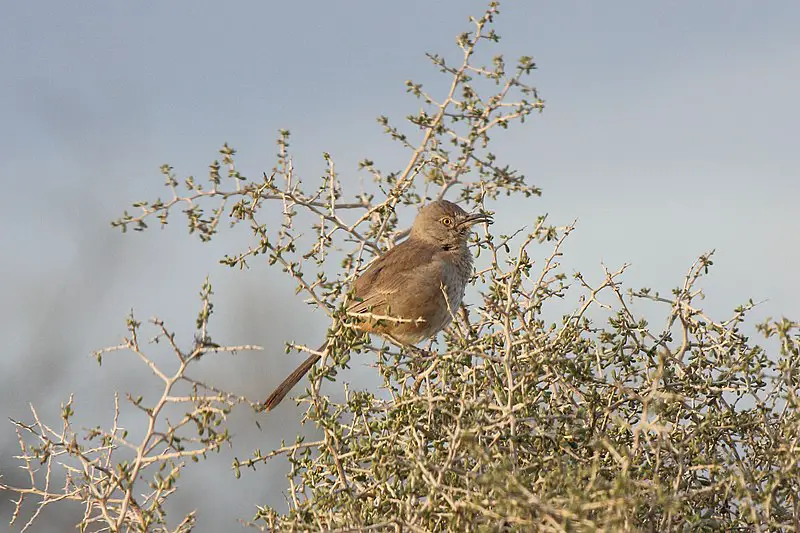
Bendire’s thrasher is a bird species commonly found in the southwestern United States and northwestern Mexico.
This medium-sized bird typically measures 23-28 centimeters in length and has a long tail and medium-sized bill.
The bird’s upperparts are grayish-brown in color, while its underparts feature faint dark streaks on paler shades.
One of the bird’s distinctive features is its bright yellow eyes and often pale base of the lower bill.
Bendire’s thrasher is known for its unique and beautiful song, which is often heard during breeding season.
This bird species feeds mainly on insects and fruits, and can be found in various habitats, including desert scrub and chaparral.
Despite occasional threats from urbanization and habitat destruction, populations of Bendire’s thrasher remain stable in many parts of its range, largely thanks to conservation efforts.Scientific classification:
| Kingdom | Animalia |
| Phylum | Chordata |
| Class | Aves |
| Order | Passeriformes |
| Family | Mimidae |
| Genus | Toxostoma |
| Species | T. bendirei |